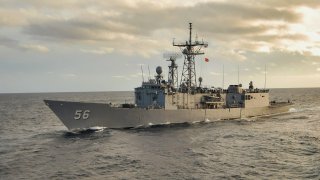USS Simpson: The Last U.S. Navy Vessel to Sink an Enemy Ship
USS Simpson was one of 51 Oliver Hazard Perry-class frigates to see service with the U.S. Navy and was among the last U.S. warships to sink an enemy vessel in combat.
On the last day of 2023, a U.S. Navy helicopter returned first and sank three small boats carrying Houthi militants in the Red Sea. It came after the boats, originating from Houthi-controlled areas in Yemen, fired crew-served and small-arms weapons at the Maersk Hangzhou, getting to within 20 meters of the vessel, and attempted to board the vessel, the United States Central Command said in a statement.
The Maersk container ship, the Singapore-flagged Hangzhou, issued a distress call saying that four small boats were attacking it. Helicopters from two U.S. ships – the USS Eisenhower and the USS Gravely – responded and issued verbal calls to the small boats, U.S. officials acknowledged.
It is increasingly looking like the U.S. Navy could find itself in a conflict – where a surface vessel sinks an adversary's vessel. That would be notable as no currently "active" U.S. Navy warship has sunk an enemy warship.
The Last U.S. Navy Vessel to Sink an Enemy Ship
When the last Oliver Hazard Perry-class frigates were decommissioned by 2015, it marked an end of the U.S. Navy's history of frigates that dated back to the Naval Act of 1794. Technically, the three-mast wooden-hulled USS Constitution – one of the six original frigates authored by the Naval Act of 1794 – is still in commission.
Moreover, the U.S. Navy won't in fact have a new class of frigates – the future Constellation-class – in service until at least 2026.
Yet, what is laely forgotten today is that when the Oliver Hazard Perry-class USS Simpson (FFG-56) was stricken from the U.S. Navy rolls, it meant that the USS Constitution has the distinction of being the only U.S. warships in service to sink an enemy vessel in combat.
The USS Simpson Goes to War
USS Simpson (FFG-56) was actually the second ship to bear the name "Simpson," but the former USS Simpson (DD-221) was named for the late Rear Admiral Edward Simpson, while the Oliver Hazard Perry-class frigate was named for Rear Admiral Rodger Whitten Simpson.
Commissioned in September 1985, FFG-56 was one of the 51 Oliver Hazard Perry-class frigates to see service with the U.S. Navy and was among the last U.S. warship to sink an enemy vessel in combat.
That occurred on April 18, 1988, when the USS Simpson took part in Operation Praying Mantis, the U.S. response to the mining of the USS Samuel B. Roberts (FFG-58), which had hit an Iranian M-08 mine four days earlier.
USS Simpson came under fire from the Iranian Navy's Kaman-class missile patrol boat Joshan, which was armed with U.S.-made Harpoon missiles dating back to the pre-Islamic Revolution. The Joshan fired several salvos at the U.S. vessels.
The Iran missiles missed their target.
Along with the U.S. Navy's Belknap-class guided-missile destroyer USS Wainwright (CG-28), and the Knox-class frigate USS Bagley (FF-1069), FFG-56 quickly returned fire. Unlike the Iranians, they didn't miss and USS Simpson's first missile slammed into the Joshan. Three more missiles from the USS Simpson and fire from the USS Wainwright further struck the Joshan, which was sunk by combined gunfire.
It was the only ship-versus-ship missile duel in U.S. Navy history, with opposing missiles airborne at the same time.
The Oliver Hazard Perry-class frigate was awarded the Joint Meritorious Unit Award and the Combat Action Ribbon for this operation, and the Armed Forces Expeditionary Medal for the deployment.
After the USS Bagley and USS Wainwright were decommissioned in 1991 and 1993 respectively, USS Simpson became the last modern U.S. Navy warship to sink an enemy vessel in action. The 30-year-old frigate was subsequently decommissioned in October 2015.
"We don't do battles like that anymore," the USS Simpson's final executive officer, Lt. Eddie Davis, told CNN following the decommissioning. "It's a tremendous feat for a ship like this to be able to do."
A Major Moment in U.S. Navy History
Though Operation Praying Mantis isn't so well remembered as other U.S. naval engagements, author Craig Symonds described it as one of the five most significant naval battles in American history in his 2005 book, Decision at Sea.
The others according to Symonds included Oliver Hazard Perry's defeat and capture of a Royal Navy squadron on Lake Erie in the War of 1812; the Civil War battle of the ironclads USS Monitor and CSS Virginia; Dewey's defeat of the Spanish flotilla in Manila Bay; and the Battle of Midway, which changed the course of World War II in the Pacific.
However, according to Symonds, Operation Praying Mantis established the United States as the world's undisputed superpower, with the ability to make real-time battlefield decisions from thousands of miles away, while it highlighted the ability to accurately fire missiles that could hit ships they could only see electronically. The brief engagement in 1988 showed that the U.S. could integrate all branches of the military service into a cohesive machine.
That fact should be remembered by the Houthi rebels now operating as pirates in the Red Sea, as well as by Tehran. The latter has the dubious distinction of having the last warship sunk by the U.S. Navy!
Author Experience and Expertise
Peter Suciu is a Michigan-based writer. He has contributed to more than four dozen magazines, newspapers, and websites with over 3,200 published pieces over a twenty-year career in journalism. He regularly writes about military hardware, firearms history, cybersecurity, politics, and international affairs. Peter is also a Contributing Writer for Forbes.
Image Credit: Creative Commons.


